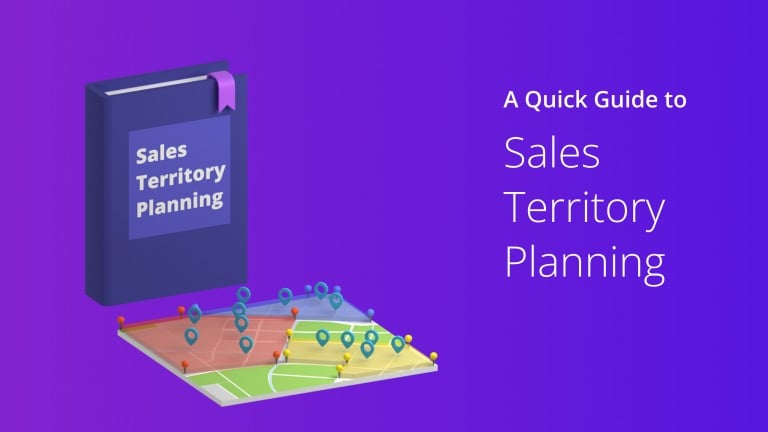Sales territory planning is an integral part of any successful sales team. But it’s not easy.
Many salespeople struggle when they don’t have a solid plan in place. They find themselves spread too thin, wasting time on unproductive activities, or missing out on potential opportunities. And that happens because of a lack of the right resources or knowledge.
So, in this blog post, we will explore the basics of effective territory management and mapping. We will also provide tips on setting up your territories for maximum efficiency and productivity and explain the advantages of using technology tools to streamline the process.
We’ll also share some insider insights on overcoming common hurdles and pitfalls that salespeople often face, so you can avoid them like a pro. So, let’s dive in and strengthen your sales territory plans.
Table of Contents
What is Sales Territory Planning?
Sales territory planning refers to creating and managing sales territories for a business. It involves dividing key geographic areas into different sections or territories, assigning leads to salespeople, and setting quotas or targeted goals for each salesperson to achieve.
Let’s say you want to launch a product in three regions or states – New York, New Jersey, and Pennsylvania.
You would first need to divide those regions into smaller subregions or territories. Then, you must assign particular customer groups or leads within those regions to individual salespeople.
Lastly, you need to set specific sales goals for the salespeople to their assigned territories. By doing this, you can track and measure sales success more accurately on a regional level.
In your sales territory plan, you may need to prioritize spending more time in the areas with more potential customers and higher demand for your product.
You may also need to focus on specific industries or target certain types of businesses that are more likely to be interested in your product.
A sales territory management plan can also involve analyzing data and market research to identify trends and opportunities.
For example, you might use data to discover that a particular industry has a high demand for your product in a specific region. You can adjust your sales territory plan accordingly to capitalize on that opportunity.
Want To See For Yourself How Route4Me Can Help You Hone Your Sales Game?

Benefits of Sales Territory Planning
Here are some critical advantages of an effective sales territory management plan and why you should embrace this technique.
More Organized and Structured Approach to Sales
A sales territory management plan helps create a well-defined sales plan with clear goals and objectives for each territory. This ensures that you have a systematic approach to your sales efforts. It helps sales reps stay focused, organized, and aligned with the company’s sales strategies.
It also helps prioritize sales activities based on the potential of each territory, optimizing time and effort.
Reduces Travel Time and Costs
Sales territory planning helps optimize travel time and costs by strategically grouping customers within a specific territory. This minimizes unnecessary travel and reduces associated costs, such as transportation expenses and accommodation.
Enables You To Focus More on Customer Requirements
With well-defined sales territories, you or your sales team can better understand customers’ unique requirements and preferences within each region. This allows you to tailor your sales approach and provide more personalized solutions to their requirements.
Focusing on customer needs can establish stronger relationships with customers, which, in turn, encourages repeat business and drives long-term revenue growth.
Balanced Workload
Proper territory planning helps you evenly distribute your sales efforts across territories, ensuring a balanced workload. This prevents you from overwhelming your sales reps with excessive sales targets in one area while neglecting others.
A balanced workload allows your sales personnel to manage their time effectively and maintain consistent sales performance across all territories.
Offers Better View into Trends and Insights
An effective sales territory management plan gives you a better view of trends and insights within each territory.
You can identify patterns, preferences, and emerging opportunities by analyzing sales data and customer feedback. This allows you to adapt your sales strategies accordingly, capitalize on trends, increase sales productivity, and stay ahead of the competition.
How to Create an Effective Sales Territory Plan
Below are some crucial steps to make sales territory management efficient.
Define Your Target Market
To get started with sales territory management and planning, it’s essential to first define the market you want to target. This can involve identifying your target customers, analyzing their requirements, and evaluating the competition.
You can create more targeted and effective sales strategies with a solid market understanding.
Example: If you sell a software product for small businesses, your market may include small business owners in specific industries, such as retail or hospitality, within a specific geographic region.
Tip: Conduct thorough market research, leverage customer data, and seek input from your sales team and managers to ensure a comprehensive understanding of your market.
Conduct a SWOT Analysis
Once you have identified your target market, conduct a SWOT analysis. It helps you understand the strengths and weaknesses of your product, team, competitors, opportunities, and threats in your market.
This will give you a better understanding of the market trends, competitive landscape, and potential risks.
Example: A strength may be your product’s unique features, while a weakness could be limited brand awareness. An opportunity may be a growing market segment, while a threat could be increasing competition.
Tip: Involve your sales team in the SWOT analysis process to get diverse perspectives and insights as they are on the front lines of selling.
Assess the Quality of Your Accounts
Not all accounts are created equal, so you must assess the quality of your accounts. Evaluate factors such as profitability, customer loyalty, buying behavior of each account, and future revenue potential.
This will help you identify which accounts to prioritize and focus on those with the most significant sales potential.
Example: High-quality accounts may include long-standing customers with a history of repeat purchases, accounts with a high lifetime value, or accounts that align with your ideal customer profile.
Tip: Utilize data and analytics tools to assess the quality of accounts and prioritize efforts accordingly.
Multi-Stop Route Planner App

Assess the Strength of Your Sales Team
Assess each salesperson’s skills, experience, and knowledge to determine which areas they are well-equipped to handle the sales opportunities and challenges in their respective territories.
You could then provide additional training, mentoring, or resource to help them close more sales.
Set Clear Sales Goals and Objectives
Once you have identified your team’s strengths, establish clear goals and break them into targets, such as monthly or quarterly sales quotas, and communicate them clearly to your team.
Example: If your sales goal is to achieve $500,000 in revenue in a specific territory within a quarter, your targets could be to close 10 new deals, upsell to 20 existing customers, and generate 50 new leads.
Tip: Make sure your goals are realistic, achievable, and aligned with your overall sales strategy.
Clearly Define Roles and Responsibilities
Establishing clear roles and responsibilities for each sales team member to ensure everyone is aligned and working towards the same goals.
Example: The responsibilities of a sales rep in a specific territory may include prospecting and qualifying leads, conducting sales presentations, negotiating contracts, and providing post-sales support.
Tip: Create a collaborative environment where team members can share best practices, support each other, and leverage each other’s strengths.
Encourage Open Communication
Establish open communication channels between your team members, sales managers, and other stakeholders to exchange information, share updates, and address challenges.
Managers should regularly review their sales teams’ performance, provide feedback, and address challenges sales reps face. Sales reps, in turn, should share their insights, challenges, and opportunities discovered on the ground with their managers to inform future strategies.
This is critical for identifying areas of improvement and fine-tuning your sales territory plan to maximize efficiency and results.
Example: Regular team meetings, sales huddles, weekly or monthly performance reviews, one-on-one coaching sessions, and feedback surveys can facilitate effective communication.
Tip: Encourage open and honest communication, and create a culture where feedback and suggestions are valued and acted upon.
Review and Track Results
Sales reps should keep track of their progress toward their goals, analyze their performance, and identify areas for improvement.
Managers should also review sales data and provide feedback to sales reps to help them make informed decisions and optimize their strategies.
Example: Sales reps can review their sales performance metrics, such as conversion rates, deal sizes, and win/loss ratios, to identify patterns and trends in their sales efforts.
Tip: Utilize sales tracking tools or CRM software to effectively gather and analyze sales data.
Leverage Data and Insights
Sales reps should analyze data on customer preferences, buying behavior, and market trends to tailor their sales approach.
Managers should also leverage data to identify patterns and trends across territories and make data-driven decisions to optimize sales strategies.
Example: Sales reps can analyze customer data to identify cross-selling or upselling opportunities or identify potential new markets for their product based on market research.
Tip: Provide training or resources to sales reps on effectively analyzing and utilizing data in their sales efforts.
3 Tools You Can Use to Create a Sales Territory Plan
Sales Territory Planning Software
It helps you ensure that sales reps are assigned the correct accounts and that sales efforts are correctly aligned. Here are several ways such territory management software can help.
Plan Optimized Routes
You must ensure your sales reps arrive on time, or the deal may fail before meeting the prospect. And a multi-stop route optimizer solves that problem.
An advanced route optimization software like Route4Me helps plan well-optimized routes in 30 seconds. The software considers traffic, weather, roadblocks, and more constraints to ensure your sales reps get 100% accurate routes and always arrive on time.
If you opt for a cloud-based route planner like Route4Me, you can plan, manage, and track routes and performance anytime, anywhere.
Want To See For Yourself How Route4Me Can Help You Hone Your Sales Game?

Efficient Distribution of Territories
Territory management software comes with a territory mapping feature that allows you to draw and name territories, use colors for their display on their map, save the regions as groups, and plan routes based on the selected territory.
Route4Me’s territory management feature even helps you draw overlapping territories and hide or display a specific territory on the map. You can also add unlimited territories by repeating the process.
You can use this feature to segregate your sales team into different regions and ensure each of their set of stops are relatively close together. It helps ensure your team can cover more prospects or clients in less time, ultimately leading to more sales.
Balance Territories
With Rotue4Me’s route planner, you can divide the workload evenly among your team. This helps you ensure no sales rep is overworked and happy at work. Plus, you don’t need to pay overtime costs.
Track Performance
An advanced sales territory mapping software like Route4Me has an interactive map feature that helps you identify where you excel and which areas you need more effort. Therefore, you can create or amend your sales plan to shift and focus your efforts where necessary.
Monitor Sales Reps on the Road
Route4Me offers a GPS tracker that helps you monitor your sales reps’ on the road to ensure they stay on schedule. It also enables you to ensure driver safety.
Learn in detail the top ten benefits of GPS tracking.
Improve Your Future Planning
The best route planners like Route4Me enable you to create mock routes which help you assess the expansion costs.
In addition, such software offers a reporting and analytics feature that helps you identify fuel expenses, the time your sales reps take to get to every customer, how long the sales personnel stay at each prospect’s location, and more. All these data help you better prepare for the future.
Learn in detail why every sales manager needs sales territory mapping software.







